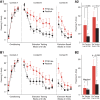Impact of predatory threat on fear extinction in Lewis rats
- PMID: 20929713
- PMCID: PMC2948889
- DOI: 10.1101/lm.1948910
Impact of predatory threat on fear extinction in Lewis rats
Abstract
Humans with post-traumatic stress disorder (PTSD) are deficient at extinguishing conditioned fear responses. A study of identical twins concluded that this extinction deficit does not predate trauma but develops as a result of trauma. The present study tested whether the Lewis rat model of PTSD reproduces these features of the human syndrome. Lewis rats were subjected to classical auditory fear conditioning before or after exposure to a predatory threat that mimics a type of traumatic stress that leads to PTSD in humans. Exploratory behavior on the elevated plus maze 1 wk after predatory threat exposure was used to distinguish resilient vs. PTSD-like rats. Properties of extinction varied depending on whether fear conditioning and extinction occurred before or after predatory threat. When fear conditioning was carried out after predatory threat, PTSD-like rats showed a marked extinction deficit compared with resilient rats. In contrast, no differences were seen between resilient and PTSD-like rats when fear conditioning and extinction occurred prior to predatory threat. These findings in Lewis rats closely match the results seen in humans with PTSD, thereby suggesting that studies comparing neuronal interactions in resilient vs. at-risk Lewis rats might shed light on the causes and pathophysiology of human PTSD.
Figures




Similar articles
-
Effects of vagus nerve stimulation on extinction of conditioned fear and post-traumatic stress disorder symptoms in rats.Transl Psychiatry. 2017 Aug 22;7(8):e1217. doi: 10.1038/tp.2017.191. Transl Psychiatry. 2017. PMID: 28892066 Free PMC article.
-
Stress-induced enhancement of fear conditioning and sensitization facilitates extinction-resistant and habituation-resistant fear behaviors in a novel animal model of posttraumatic stress disorder.Physiol Behav. 2012 Jan 18;105(2):408-16. doi: 10.1016/j.physbeh.2011.08.037. Epub 2011 Sep 8. Physiol Behav. 2012. PMID: 21925525
-
Acoustic startle response in rats predicts inter-individual variation in fear extinction.Neurobiol Learn Mem. 2017 Mar;139:157-164. doi: 10.1016/j.nlm.2017.01.008. Epub 2017 Jan 25. Neurobiol Learn Mem. 2017. PMID: 28131759
-
From Pavlov to PTSD: the extinction of conditioned fear in rodents, humans, and anxiety disorders.Neurobiol Learn Mem. 2014 Sep;113:3-18. doi: 10.1016/j.nlm.2013.11.014. Epub 2013 Dec 7. Neurobiol Learn Mem. 2014. PMID: 24321650 Free PMC article. Review.
-
The clinical applications and practical relevance of human conditioning paradigms for posttraumatic stress disorder.Prog Neuropsychopharmacol Biol Psychiatry. 2019 Jan 10;88:339-351. doi: 10.1016/j.pnpbp.2018.08.014. Epub 2018 Aug 19. Prog Neuropsychopharmacol Biol Psychiatry. 2019. PMID: 30134147 Review.
Cited by
-
Effects of RU486 in Treatment of Traumatic Stress-Induced Glucocorticoid Dysregulation and Fear-Related Abnormalities: Early versus Late Intervention.Int J Mol Sci. 2022 May 14;23(10):5494. doi: 10.3390/ijms23105494. Int J Mol Sci. 2022. PMID: 35628305 Free PMC article.
-
Animal models of post-traumatic stress disorder: face validity.Front Neurosci. 2013 May 31;7:89. doi: 10.3389/fnins.2013.00089. eCollection 2013. Front Neurosci. 2013. PMID: 23754973 Free PMC article.
-
Altered responsiveness of BNST and amygdala neurons in trauma-induced anxiety.Transl Psychiatry. 2016 Jul 19;6(7):e857. doi: 10.1038/tp.2016.128. Transl Psychiatry. 2016. PMID: 27434491 Free PMC article.
-
Molecular and Cellular Effects of Traumatic Stress: Implications for PTSD.Curr Psychiatry Rep. 2017 Sep 25;19(11):85. doi: 10.1007/s11920-017-0841-3. Curr Psychiatry Rep. 2017. PMID: 28944401 Free PMC article. Review.
-
Tempering aversive/traumatic memories with cannabinoids: a review of evidence from animal and human studies.Psychopharmacology (Berl). 2019 Jan;236(1):201-226. doi: 10.1007/s00213-018-5127-x. Epub 2019 Jan 2. Psychopharmacology (Berl). 2019. PMID: 30604182 Review.
References
-
- Adamec RE, Shallow T 1993. Lasting effects on rodent anxiety of a single exposure to a cat. Physiol Behav 54: 101–109 - PubMed
-
- Adamec R, Head D, Blundell J, Burton P, Berton O 2006. Lasting anxiogenic effects of feline predator stress in mice: Sex differences in vulnerability to stress and predicting severity of anxiogenic response from the stress experience. Physiol Behav 88: 12–29 - PubMed
-
- Afifi TO, Asmundson GJ, Taylor S, Jang KL 2010. The role of genes and environment on trauma exposure and posttraumatic stress disorder symptoms: A review of twin studies. Clin Psychol Rev 30: 101–112 - PubMed
-
- Apfelbach R, Blanchard CD, Blanchard RJ, Hayes RA, McGregor IS 2005. The effects of predator odors in mammalian prey species: A review of field and laboratory studies. Neurosci Biobehav Rev 29: 1123–1144 - PubMed
-
- Armario A, Escorihuela RM, Nadal R 2008. Long-term neuroendocrine and behavioural effects of a single exposure to stress in adult animals. Neurosci Biobehav Rev 32: 1121–1135 - PubMed
Publication types
MeSH terms
Grants and funding
LinkOut - more resources
Full Text Sources
Medical
